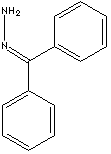PRODUCT IDENTIFICATION

CLASSIFICATION
PHYSICAL AND CHEMICAL PROPERTIES
AUTOIGNITION
NFPA RATINGS
REFRACTIVE INDEX
FLASH POINT
146 C
GENERAL DESCRIPTION AND APPLICATIONS
Hydrazine (anhydrous) is a clear, fuming, corrosive liquid with an ammonia-like odor; melting at 1.4 C, boiling at 113.5 C, specific gravity 1.011. It is very soluble in water and soluble in alcohol. It decomposes on heating or exposure to UV to form ammonia, hydrogen, and nitrogen, which may be explosive with a blue flame when catalysed by metal oxides and some metals such as platinum or Raney nickel. It is prepared from ammonia with chloramine in the presence of glue or gelatin (to inhibit decomposition of the hydrazine by unreacted oxidants) as the hydrate form usually (100% monohydrate contains 64% by weight hydrazine). Hydrazine is also prepared from sodium hypochlorite with urea in the presence of glue or gelatin. Hydrazine is used as a component in jet fuels because it produce a large amount of heat when burned. Hydrazine is used as an oxygen scavenger for boiler feed water to prevent corrosion damage. Hydrazine is used as a reducing agent for the recovery of precious metals and as a chain extender in urethane coatings. Hydrazine is dibasic and very reactive. It and its derivatives have active applications in organic synthesis for agrochemicals, pharmaceuticals and stabilizers, polymerization catalysts, flame-retardants, blowing agents for plastics. Hydrazone is a compound containing the group -NH·N:C-. It is formed from a condensation reaction aldehydes or ketones with hydrazines (commonly phenylhydrazine). It is used as a an exotic fuel. Aromatic hydrazones are used to form indoles by a ring closure reaction (Fischer synthesis). Hydrazones and hydrazines are converted to aldehydes and ketones to corresponding hydrocarbons by heating the carbonyl compound with sodium ethoxide (Wolf-Kishner reduction). Benzophenone Hydrazone is used as a intermediate in the manufacture of UV absorbers and heterobicyclic organic compounds and pharmaceuticals (such as diphenhydramine).
APPEARANCE
99.0% min
MELTING POINT
95 - 99 C
GENERAL DESCRIPTION OF BENZOPHENONE
Chemical ingredients for sunscreen are;
- p-Aminobenzoic acids
- p-Aminobenzoic acid (CAS #: 150-13-0)
- p-Aminobenzoic Acid, monoglyceryl Ester (CAS #: 136-44-7)
- p-Aminobenzoic Acid, octyl dimethyl Ester (Padimate 0, CAS #: 21245-02-3)
- p-Aminobenzoic Acid, ethyl dihydroxypropyl (Roxadimate, CAS #: 58882-17-0)
- p-Aminobenzoic Acid, 2,4-dihydroxy-N-(3-hydroxypropyl)-3,3-dimethylbutanamide ester
- Octyl Triazone (CAS #: 88122-99-0)
- p-Aminobenzoic Acid, PEG-25 (CAS #: 116242-27-4)
- Anthranilates
- Menthyl anthranilate (CAS #: 134-09-8)
- Benzophenones
- Benzophenone (CAS #: 119-61-9)
- 2,4-Dihydroxybenzophenone (Benzophenone-1, CAS #: 131-56-6)
- 2,2',4,4'-Tetrahydroxybenzophenone (Benzophenone-2, CAS #: 131-55-5)
- 2-Hydroxy-4-methoxybenzophenone (Benzophenone-3, Oxybenzone, CAS #: 131-57-7)
- 2-Hydroxy-4-methoxybenzophenone-5-sulfonic Acid (Benzophenone-4, Sulisobenzone, CAS #: 4065-45-6
- 2-Hydroxy-4-methoxybenzophenone-5-sulfonic Acid, Monosodium Salt (Benzophenone-5, CAS #: 6628-37-1)
- 2,2'-Dihydroxy-4,4'-dimethoxybenzophenone (Benzophenone-6, CAS #: 131-54-4)
- 5-Chloro-2-hydroxybenzophenone (Benzophenone-7, CAS #: 85-19-8)
- 2,2'-Dihydroxy-4-methoxybenzophenone (Benzophenone-8, Dioxybenzone, CAS #: 131-53-3)
- 2,2'-Dihydroxy-4,4'-dimethoxybenzophenone-5,5'-disulfonic Acid Sodium Salt (Benzophenone-9, CAS #: 76656-36-5)
- 2-Hydroxy-4-methoxy-4'-methyl-benzophenone (Benzophenone-10, Mexenone, CAS #: 1641-17-4)
- Bis(2,4-ihydroxyphenyl)Methanone (Benzophenone-11, CAS #: 1341-54-4)
- 2-Hydroxy-4-(Octyloxy)Benzophenone (Benzophenone-12, Octabenzone, CAS #: 1843-05-6)
- 2,2'-Dihydroxy-4-methoxybenzophenone (Dioxybenzone, CAS #: 131-53-3)
- 2-Hydroxy-4-methoxybenzophenone (Oxybenzone, CAS #: 131-57-7)
- 2-Hydroxy-4-methoxybenzophenone-5-sulphonic Acid (Sulisobenzone, CAS #: 4065-45-6)
- Camphors
- Benzylidene Camphor Sulfonic Acid (CAS #: 56039-58-8)
- 3-Benzylidene Camphor (CAS #: 15087-24-8)
- Polyacrylamidomethyl Benzylidene Camphor (CAS #: 113783-61-2)
- Terephthalylidene Dicamphor Sulfonic Acid (CAS #: 90457-82-2)
- 3-(4-Methylbenzyliden)Camphor (CAS #: 36861-47-9)
- Camphor Benzalkonium Methosulfate (CAS #: 52793-97-2)
- Bornelone (CAS #: 2226-11-1)
- Cinnamates
- Ethyl Cinnamate (CAS #: 103-36-6)
- 2-Ethoxyethyl-p-methoxycinnamate (Cinoxate, CAS #: 104-28-9)
- Isoamyl P-methoxycinnamate (CAS #: 71617-10-2)
- Diisopropyl Methyl Cinnamate (CAS #: 32580-71-5)
- 2-Ethylhexyl Alpha-cyano-beta-phenylcinnamate (Octocrylene, CAS #: 6197-30-4)
- Diethanolamine Methoxycinnamate (CAS #: 56265-46-4)
- Isopropyl Methoxycinnamate (CAS #: 5466-76-2)
- Isoamyl P-methoxycinnamate (CAS #: 71617-10-2)
- Glyceryl Octanoate Dimethoxycinnamate
- Ethyl Diisopropylcinnamate (CAS #: 32580-72-6)
- Ethyl Methoxycinnamate (CAS #: 99880-64-5)
- Octyl Methoxycinnamate (CAS #: 5466-77-3)
- Dibenzoylmethanes
- Dibenzoylmethane (CAS #: 120-46-7)
- Isopropyl Dibenzoylmethane (Eusolex, CAS #: 63250-25-9)
- 4-tert-Butyl-4'-methoxy-dibenzoylmethane (Avobenzone, CAS #: 70356-09-1)
- Salicylates
- 3,3,5-Trimethylcyclohexyl Salicylate (Homosalate, CAS #: 118-56-9)
- Benzyl Salicylate (CAS #: 118-58-1)
- Octyl Salicylate (CAS #: 118-60-5)
- 2-Hydroxyethyl Salicylate (CAS #: 87-28-5)
- Menthyl Salicylate (CAS #: 89-46-3)
- Isopropylbenzyl Salicylate (CAS #: 94134-93-7)
- Imidazoles
- Phenylbenzimidazole
- Phenylbenzimidazol-5-sulfonic Acid (CAS #: 27503-81-7)
- Phenylbenzimidazole Tea Sulfonate (CAS #: 73705-00-7)
- Urocanic Acid (4-Imidazoleacrylic Acid, CAS #: 104-98-3)
- Ethyl Urocanate (CAS #: 27538-35-8)
- Bisymidazylate (CAS #: 180898-37-7)
- Sodium Phenylbenzimidazole Sulfonate (CAS #: 5997-53-5)
- Others
- Petrolatum Jelly (CAS #: 8009-03-8)
- Ethyl 2-cyano-3,3-diphenylacrylate (Etocrilene, CAS #: 5232-99-5)
- Diurethane Dimethacrylate (CAS #: 103597-45-1)
- Drometrizole Trisiloxane (CAS #: 155633-54-8)
- Bis(Ethylhexyloxyphenol Methoxyphenol) Triazine (CAS #: 187393-00-6
- 2-(2-Hydroxy-5-methyl-phenyl)Benzotriazole (Drometrizole, CAS #: 2440-22-4)
- Dioctyl Butamido Triazone (CAS #: 154702-15-5)
- Inorganic compounds (physical sunscreens)
- Titanium dioxide
- Zinc oxide
PRICES